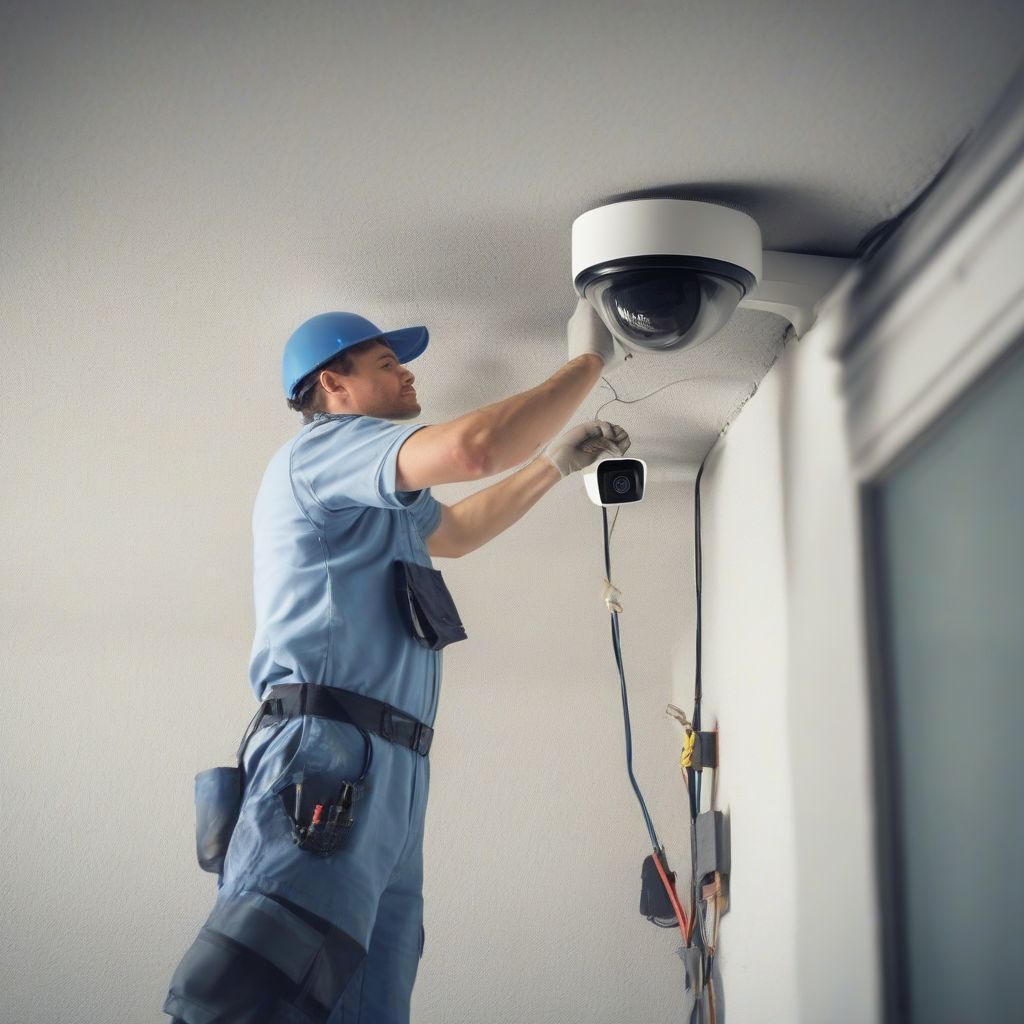In today’s world, security is paramount for both homes and businesses. Installing security cameras is a proactive step towards deterring crime and ensuring peace of mind. By capturing valuable evidence and providing a watchful eye, security cameras act as a powerful tool for safeguarding your property and loved ones. This comprehensive guide will delve into the intricacies of installing security cameras, covering everything from choosing the right system to legal considerations and expert installation tips.
Understanding Security Camera Systems
Before embarking on the installation process, it’s crucial to understand the different types of security camera systems available. Choosing the right system depends on your specific needs, budget, and the level of security required.
Types of Security Cameras:
-
IP Cameras: These cameras transmit video footage over the internet, allowing for remote monitoring through smartphones, tablets, or computers. They offer flexibility, scalability, and advanced features like motion detection and cloud storage.
-
Analog Cameras: Traditional analog cameras transmit video signals through coaxial cables to a Digital Video Recorder (DVR). While offering a cost-effective solution, they lack the advanced features of IP cameras.
-
Wireless Cameras: As the name suggests, wireless cameras transmit video signals wirelessly, eliminating the need for extensive cabling. They are easy to install and offer flexibility in placement.
Key Features to Consider:
-
Resolution: Higher resolution cameras provide clearer images, aiding in identification and evidence gathering.
-
Night Vision: Essential for 24/7 surveillance, night vision cameras use infrared LEDs to capture clear footage in low-light conditions.
-
Field of View: The camera’s field of view determines the area it can cover. Wide-angle lenses provide a broader view, while narrow-angle lenses focus on specific areas.
-
Motion Detection: This feature triggers recording or alerts when motion is detected, conserving storage space and improving efficiency.
-
Storage Options: Security footage can be stored locally on a DVR, Network Video Recorder (NVR), or in the cloud. Cloud storage offers convenience and off-site backup.
Installation Process: A Step-by-Step Guide
 Security Camera Installation
Security Camera Installation
1. Planning and Design:
-
Identify Vulnerable Areas: Determine the areas needing the most surveillance, such as entry points, perimeters, and valuable assets.
-
Camera Placement: Consider the camera’s field of view, lighting conditions, and potential obstacles.
-
Wiring and Connectivity: Plan the cabling routes for power and data transmission, opting for wired or wireless connections based on your chosen system.
2. Mounting and Cabling:
-
Secure Mounting: Mount cameras securely on walls, ceilings, or poles using appropriate brackets and screws.
-
Conceal Wiring: Run cables discreetly through walls, ceilings, or conduits to prevent tampering or accidental damage.
-
Power Supply: Ensure cameras are connected to a reliable power source, either through AC adapters or Power over Ethernet (PoE) injectors.
3. Configuration and Setup:
-
Network Configuration: Connect the cameras to your network and configure IP addresses, network settings, and recording parameters.
-
Remote Access: Set up remote access through mobile apps or web interfaces to monitor live feeds and access recordings.
-
Motion Detection Settings: Configure motion detection zones and sensitivity levels to minimize false alarms.
Legal Considerations and Privacy
Installing security cameras comes with legal and ethical responsibilities. It’s crucial to comply with local laws and regulations regarding surveillance and privacy.
-
Privacy Expectations: Avoid recording in areas where there is a reasonable expectation of privacy, such as restrooms or changing rooms.
-
Signage and Notification: Post clear signage indicating the presence of security cameras to inform individuals they are being recorded.
-
Data Protection: Implement measures to protect recorded footage from unauthorized access, disclosure, or misuse.
Benefits of Professional Installation
While DIY installation is possible for basic systems, seeking professional installation offers numerous advantages:
-
Expert Knowledge: Certified technicians possess the expertise to recommend the right system, optimize camera placement, and ensure proper configuration.
-
Code Compliance: Professionals are well-versed in local building codes and regulations, ensuring your installation meets safety standards.
-
Clean Installation: Technicians have the tools and skills to conceal wiring and mount cameras discreetly, enhancing aesthetics and deterring vandalism.
-
System Integration: Professionals can integrate your security cameras with other security systems, such as alarms or access control, for a comprehensive solution.
Maintaining Your Security System
Once installed, regular maintenance is crucial to ensure the longevity and effectiveness of your security camera system.
-
Cleaning Lenses: Regularly clean camera lenses to maintain image clarity and prevent dust buildup.
-
Firmware Updates: Keep your cameras and recording devices updated with the latest firmware to benefit from bug fixes and feature enhancements.
-
Storage Management: Regularly review and delete old footage to free up storage space or consider upgrading storage capacity if needed.
Conclusion
Installing security cameras is a wise investment in safeguarding your property and peace of mind. By understanding the different system types, following a structured installation process, and addressing legal considerations, you can create a robust security solution. Seeking professional installation ensures expert guidance, code compliance, and seamless integration with other security measures. Remember to maintain your system regularly to maximize its lifespan and effectiveness.